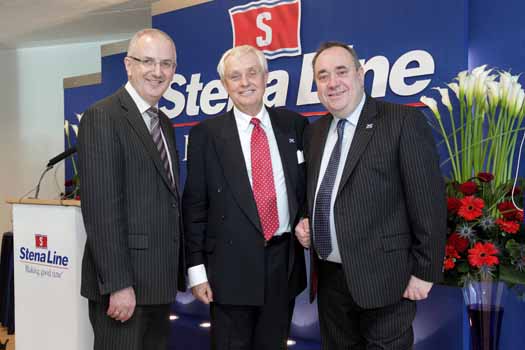The new 27 acre port is one of the most modern port facilities in the UK and heralds the start of a new route between Scotland and Northern Ireland, which will be serviced by two new ships, Stena Superfast VII and Stena Superfast VIII, the largest ferries ever to sail between the two countries.

(l-R) Minister for Regional Development Danny Kennedy, MLA, Dan Sten Olsson, Chairman of Stena Line and Scotland's First Minister Alex Salmond
The new ships will complete the crossing in 2 hours 15 minutes and will operate 12 scheduled sailings per day between Cairnryan and Belfast.
The opening of the new port brings Stena Line's recent investment in the service to a massive £200M, which also includes the opening in 2008 of the VT4 port in Belfast, and safeguards the ferry link between Scotland and Northern Ireland for the next generation.
Dan Sten Olsson, Chairman of Stena Line said: "Today is a historic day for the people of Scotland and Northern Ireland. The long term future of this important ferry link between both countries has been secured for future generations and I'm delighted that Stena Line has been able to play its part in maintaining a connection between both countries which goes back over 150 years.
"This investment represents one of the biggest financial route commitments ever made by Stena Line and I'm delighted that after years of planning and hard work the day has finally arrived when we can enjoy using one of the most modern port and terminal facilities in the UK. We have built a facility that will support and stimulate both leisure and freight markets and we are confident that this and the next generation will continue to see ferry travel as an important part of their travel plans."
I am confident that our leisure and freight customers will see that we have taken great care to meet their needs constructing a service and facilities around them and I look forward to the prospect of Cairnryan – Belfast becoming one of the leading ferry services on the Irish Sea."
Speaking at the opening First Minister Alex Salmond said:
"I am absolutely thrilled to be at the Loch Ryan port to open this hugely impressive and important new gateway to Scotland. It is exciting to see how this former brownfield site has been transformed into a 21st century ferry port in less than two years, safeguarding hundreds of jobs at the terminal and ensuring this historic ferry link continues for generations to come.
"As well as being the first of the projects from our Second National Planning Framework to be completed, the work here represents a major investment by Stena Line and is a demonstration of their commitment to Scotland. As passengers will see, the terminal facilities at Loch Ryan are first class, and will serve two outstanding refitted vessels that will reduce journey times and be more fuel efficient. These are exciting times for all those involved in Stena Line, and I extend my warmest congratulations to those that have brought this fantastic project to completion."
Addressing the audience at Loch Ryan today, Minister for Regional Development in Northern Ireland, Danny Kennedy MLA, said: "This significant investment by Stena Line in Loch Ryan complements the company's earlier investment in the modern facilities at the Port of Belfast, which handles 60% of Northern Ireland's seaborne trade.
"The link across the North Channel is of great economic, social and cultural importance to both countries. The recent major investments in harbour facilities in Scotland and Northern Ireland, culminating with the arrival of Stena Line's new ships on this route, will help strengthen this commercial link and its trading position."
Scheduled sailings from the new Loch Ryan Port began on Monday November 21st with 10 crossings per day which will increase to 12 sailings from December 5th.































































